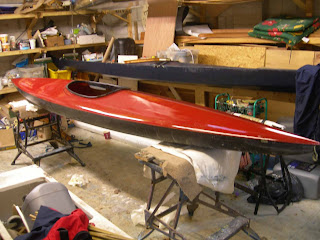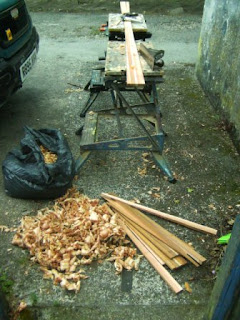Something different - Paddling a 50 year old slalom kayak on the sea
Paddling the Mendesta Slalom kayak nearly 50 years on
No construction posts until I sort out the problem with the camera (I would have covered marking out and cutting the frames).
Instead I will focus on the Friday night Club paddle at Penzance when I took the opportunity to give the old Slalom Kayak I brought earlier this year it's fourth outing. I will use the post to compare and contrast the Mendesta with more modern sea kayaks; back in the 1960's and early 70's they were used as sea kayaks, as well as for everything else.
The kayak was might have been made in Belgium where it originated or under license over here - research in the UK rivers guidebook suggests that they were marketed by Jaycee (along with their own range of kayaks) from 1964; probably until the early/mid1970's when the design would have been considered obsolete due to the high profile - particularly the rear deck. There were quite a few about however.
Having started paddling in 1965 I would have used many similar kayaks, but not this model as the seat was too narrow to sit in - and my hips were just as wide when I was young. I had to remove the seat, widen it and fit it back in the boat - which was done back in the spring when the photo was taken.
How it compares - off the water
No construction posts until I sort out the problem with the camera (I would have covered marking out and cutting the frames).
Instead I will focus on the Friday night Club paddle at Penzance when I took the opportunity to give the old Slalom Kayak I brought earlier this year it's fourth outing. I will use the post to compare and contrast the Mendesta with more modern sea kayaks; back in the 1960's and early 70's they were used as sea kayaks, as well as for everything else.
The kayak was might have been made in Belgium where it originated or under license over here - research in the UK rivers guidebook suggests that they were marketed by Jaycee (along with their own range of kayaks) from 1964; probably until the early/mid1970's when the design would have been considered obsolete due to the high profile - particularly the rear deck. There were quite a few about however.
Having started paddling in 1965 I would have used many similar kayaks, but not this model as the seat was too narrow to sit in - and my hips were just as wide when I was young. I had to remove the seat, widen it and fit it back in the boat - which was done back in the spring when the photo was taken.
How it compares - off the water
- Dimensions 4 metres (13' 1'') by 60 cm (23 1/2'') the modern slalom boats are 3.5m with same beam.
- Fittings - bow & stern loops and that's it. There was no buoyancy and the footrest was of a very basic type which would not have been fitted beyond 1968/9 when there were a number of drownings. It was found that paddler's feet could jam behind the footrest on impact, so that they would be unable to exit the boat if they subsequently capsized. I will be fitting foot-pegs and currently have an air bag in the back and will be fitting one in front of the footrest.
Most of these early boats had better fittings - basic toggles bow & stern (people quickly found that loops of a rotating kayak could trap the fingers), and a continuous deck line from bow to stern both sides to which a swimmer could cling (they would sit quite nicely just above the gunwale). Polystyrene buoyancy was often stuffed in to the bow forward of the footrest and aft of the cockpit I recall, before pillar buoyancy was moulded in. - Weight - 18kg, 40lb. At this weight the kayak was probably of a heavy construction (over 3 oz/ sq ft) as the weight of a standard lay up was approx 30-35 lb. That is probably why it has survived all this time. Even of this heavy lay-up, the boat was a doddle to carry with one hand. A similarly sized plastic boat would have been much heavier.
- Comfort & convenience; at 60 cm length the cockpit is longer than an ocean pattern but shorter than a keyhole so that you have to sit on the rear rim of the cockpit to enter. Thigh grips built into the coaming edges were comfortable in use. The seat was suspended from the deck so that it floated above the bottom of the kayak. Being heavily built it did not flex sideways, and was set high - at least 2'' clear of the bottom, probably to enable the back to clear the rear of the cockpit when rolling; and also to give an efficient paddling position - these early boats were not fitted with back-straps. Even with an oversized deck (keyhole), the boat stayed quite dry when rolling.
On the Sea
The directional stability is what you would expect of a kayak designed for use in white water rivers. Thus the kayak will turn perpendicular to your course once you stop paddling unless you apply a stern rudder. You need to be able to anticipate the boat's tendency to do that when paddling too; one gets used to it. It weathercocks in winds as low as F2. This all sounds rather bad, but unlike a longer kayak, these deviations from the course are much easier to correct with less effort, so long as the direction has not strayed too far - down to anticipation again.
The hull speed is much higher than one would expect - the kayak will keep pace easily with most sea kayaks, which are actually quite slow for their length. The high seat improves paddling efficiency through a better angle of attack on the catch. Although it should reduce secondary stability through the higher centre of gravity, I did not notice this, and primary stability was good. It was an easy boat to roll.
Performance in wind and waves
In waves without wind the boat is as dry as any sea kayak due to the high volume (approx 320L) for its length and V'eed decks. Although the deck is often wet, it is rare to get something over the spray-deck in less that F4.
Paddling into wind is wet as the spray thrown up by the bow is blown toward the paddler. Weather-cocking is always worse in a cross sea whatever you are paddling, and this was no exception.
Paddling into a chop is wet and the more full bow is slowed more than a conventional sea kayak. Using a greenland paddle I had to very work hard to keep up with someone in a fast sea kayak and conventional paddles into a F4 chop. Part of the problem was the lack of lower back support which was quite tiring and the energy which had to be diverted to correcting weather-cocking.
Down wind and wave the boat shows potential as it surfs readily, however control is a problem. It needs a retractable skeg.
So far I have only tried surfing in small waves, but it tracked well enough across the wave on the few runs I had the opportunity to take while the Friday night group was going home back across a reef (the longer sea kayaks being unable to manoeuvre into the take off position).
Rock Dodging
This is where the boat scored - it was great fun round rocks, particularly with the low surgy swell that was pushing into Mount's Bay from the Atlantic. So much fun that I overcooked it and ended up having to roll in a very tight spot, and it came up very easily which was good as this was the first time I rolled it.
Verdict
Wet and fun - particularly round rocks and surf, but can not yet be considered for serious use as a sea kayak. With hatches, bulkheads, a retractable skeg, and possibly more V and volume in the hull aft of the cockpit, so that the seat could be moved aft; the weather-cocking could be resolved as well as giving the paddler a drier ride. This would have to be done whilst keeping the weight to a minimum.


Comments
Post a Comment